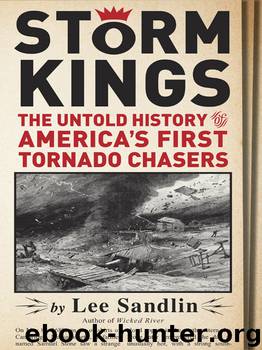Storm Kings by Lee Sandlin

Author:Lee Sandlin [Sandlin, Lee]
Language: eng
Format: epub, mobi
ISBN: 978-0-307-90816-2
Publisher: Knopf Doubleday Publishing Group
Published: 2013-03-04T16:00:00+00:00
11
Premonitory Symptoms
In the early 1880s, curious flags began appearing in prominent places all over America. They were seen flying above post offices and railroad depots and weather stations—enormous expanses of canvas, bearing bright and stark symbols that could be seen for miles away. They were the Signal Corps’s new forecast flags. A flag of solid white meant fair weather, while one of solid blue meant rain; red with a large black disk at the center meant a storm; white with a black disk was a cold wave. They showed up first in the rural West, where they could be spotted at enormous distances by anyone with field glasses, but they were such an immediate success with the public that they quickly began flying from flagpoles in major cities. The flag for the cold wave was especially valuable in farm country, where advance word of a frost could mean the survival of a harvest. Railroads sometimes flew the cold-front flag from baggage cars so that every passing train could warn farmers in their fields if they needed to take action to save their crops. The flags were a familiar sight in America for decades; they lasted until the advent of radio forecasts in the 1920s.
They were the idea of General William Hazen, who took over as chief signal officer of the corps in 1880, after the death of the corps’s first chief, Albert Myer. Hazen was a hero of the Civil War and more recently a decorated veteran of the Indian Wars. He was a successful and influential man from an exceptionally well-connected Ohio political family. His wife was the daughter of the owner of The Washington Post. But he had a better patron than that. Right around the time that he received his appointment to the Signal Corps, his childhood friend James Garfield was elected president of the United States.
Hazen was known as a fiercely contentious man who wasted no energy in getting along with his superiors. During the Civil War, he had infuriated his old boss General Sherman by claiming credit for several of Sherman’s triumphs during the March to the Sea. He had become a celebrity during the administration of President Grant, because of his exposure of the systematic corruption of the War Department’s procurement system. His whistle-blowing testimony before Congress had led to the resignation of William Belknap, Grant’s secretary of war. In 1876, during the Indian Wars, he had feuded so ferociously and so publicly with his commanding officer that he had to be reassigned. The officer was George Armstrong Custer, and that was the only reason Hazen missed the Battle of the Little Bighorn.
Hazen had no native ability as an administrator. But when he took over the Weather Bureau office on G Street, he was well liked—at first, anyway—for his determination to push the Signal Corps forward into new terrain. Unlike Myer, he was fascinated by basic scientific research. Myer had always looked for immediate results; Hazen was willing to back projects that might not bear fruit for years, if ever.
Download
This site does not store any files on its server. We only index and link to content provided by other sites. Please contact the content providers to delete copyright contents if any and email us, we'll remove relevant links or contents immediately.
How to Do Nothing by Jenny Odell(2645)
A Forest Journey by John Perlin(2587)
The Plant Messiah by Carlos Magdalena(2453)
Babylon's Ark by Lawrence Anthony(2070)
Energy Myths and Realities by Vaclav Smil(2060)
The ESV Study Bible by Crossway Bibles(1911)
Abbey in America by Murray John A(1801)
Fatal Storm by Rob Mundle(1787)
Witness Tree by Lynda V. Mapes(1693)
Shadows on the Gulf by Rowan Jacobsen(1516)
Client Earth by James Thornton(1501)
Brokeback Mountain by Annie Proulx(1470)
Coming Back to Life by Joanna Macy(1466)
Water Rights and the Environment in the United States by John Burch(1414)
Cosmos by Carl Sagan(1398)
Ten Billion by Stephen Emmott(1382)
Mycelium Running: How Mushrooms Can Help Save the World by Paul Stamets(1286)
The overachievers by Robbins Alexandra(1284)
The Uninhabitable Earth by David Wallace-Wells;(1191)
